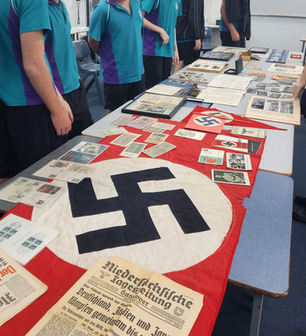- tal242
- Apr 4
- 2 min read

For many years now the Sabre team have taken collections of rare military artefacts into local schools with military history displays and workshops for schools that help bring military history to life. We call them our 'Mobile War Museums'.
We recently worked with 6 classes of Year 10 History students at Upper Coomera State College. We presented a powerful hands-on learning opportunity where students rotated through three sessions covering: WW2 German symbolism and propaganda - The changing life of a soldier from the early 1900s to today – The use of selective history and symbolism in both Japanese and German contexts to mobilise a population for war and conquest.
We carefully select and curate displays of artefacts to match what students have been taught under the Australian history curriculum. We also tailor workshop and display content to cover areas of history that teachers feel will be of great value even if they have been missed in the standard curriculum.
Why Students Should Study WWII and Military History
Understanding World War II and broader military history is crucial for school students, as it provides insights into the forces that have shaped their modern world. Beyond battles and strategy, studying this history fosters critical thinking, teaches lessons on leadership, and helps students recognise the power of propaganda and symbolism.
George Santayana famously stated, “Those who cannot remember the past are condemned to repeat it.”
This quote serves as a warning: ignorance of history allows mistakes and atrocities to resurface. By studying WWII, students gain a deeper understanding of the dangers of totalitarianism, the consequences of unchecked aggression, and the impact of ideology on global events.
One key aspect of this education is the analysis of Third Reich-era artifacts, which provide insight into how symbolism and propaganda were used to manipulate populations. Nazi imagery, for example, was designed to create unity and instil obedience. When students learn how these symbols were used to distort reality and rally support for an oppressive regime, they become better equipped to recognise modern propaganda, whether in politics, advertising, or media.
Additionally, military history teaches valuable lessons in strategy, resilience, and decision-making. Studying conflicts from ancient warfare to modern operations helps students appreciate the complexities of leadership, logistics, and diplomacy. It also fosters respect for those who have served and sacrificed for their nations.
Ultimately, educating young people on military history and WWII is not about glorifying war but about learning from it. It encourages a well-rounded perspective, instils appreciation for democratic values, and equips students with the ability to think critically about history’s role in shaping our world today.
“A huge thank you to Sabre for once again generously sharing
your artefacts and incredible military knowledge. Your support continues
to enrich our students' understanding and brings history to life in
unforgettable ways.”
Upper Coomera State College
As pround members of the Australian Museum and Galleries Association we are delighted to bring military history displays for schools to Austrslia's young history enthusiasts.

















Commentaires